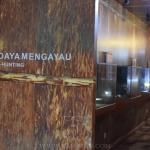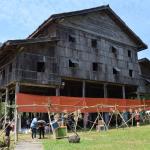Charles Hose was not just a British colonial administrator, he was a prominent zoologist and ethnologist. He also contributed to the discovery of oil in Sarawak.
Hose first arrived in Sarawak in April 1884 when he was first posted in the Baram area. He was then made the Resident of Sibu on June 1, 1904.
Between April and June 1904, Hose led a force of 200 Kayans in Belaga on an expedition to attack the Dayaks on Bukit Batu.
This group of Dayak allegedly had committed murders against other tribes for three years.
During his tenure in Sarawak, he had explored most of Sarawak’s mountainous districts, especially in the far interior of Baram area.
He collected many species of flora and fauna and then presented them to the British and other museums.
Thanks to his contribution to science, he was conferred an honorary degree by the University of Cambridge.

As for his work as a zoologist, several of these animals species were named after Hose:
1.Hose’s langur (Presbytis hosei)
In Sarawak, it lives in the lowlands and hill ranges, including the Dulit range and Usun Apau plateau.
According to Hans P. Hazebroek and Abang Kashim bin Abang Morshidi in National Parks of Sarawak, there were reports of sightings of Hose’s langur at Similajau National Park in Bintulu.
However, this might be an isolated population.
As for Niah’s lowland forest, Hose’s langur has no longer been seen where it was previously known to occur.
This animal is most often found in groups of six to eight animals. Additionally, each of this group comprises of one male, several females and their offspring.
They feed on seeds and leaves. It has four species namely Miller’s grizzled langur (Presbytis hosei canicrus), Everett’s grizzled langur (Presbytis hosei everetti), Hose’s grizzled langur (Presbytis hosei hosei) and Saban grizzled langur (Presbytis hose sabana).
2.Hose’s shrew or Bornean pygmy shrew (Suncus hosei)
This poor animal is often listed as the Etruscan shrew (Suncus etruscus) but they are actually a distinctly different species.
This species of shrew is endemic in Borneo particularly in northern Sarawak and northeastern Sabah.
Since there is little information about this animal, it has been listed as a Data Deficient species by IUCN in 2008.
3.Hose’s pygmy flying squirrel (Petaurillus hosei)
This nocturnal animal can be spotted in a nest hole in a dead tree of dipterocarp forest. Here in Borneo, Hose’s pygmy flying squirrel has been spotted in Sepilok in Sabah, Baram and Niah in Sarawak as well as in Brunei.
It is similar to the lesser pygmy flying squirrel but smaller in size and has totally pale checks.
4.Hose’s palm civet (Diplogale hosei)

Oildfield Thomas was a British zoologist who worked at the Natural History Museum. There he described over 2,000 new species and subspecies including Hose’s palm civet.
Thomas described it in 1892 a year after Hose collected the first specimen in Sarawak.
The interesting part is the first living specimen was only collected in 1997 and released after two months. That is almost a century after Hose collected it!
Besides Sarawak, Hose’s palm civet can also be found in Sabah, Brunei and Kalimantan.
5.Four-striped ground squirrel (Lariscus hosei)
Here is another species discovered by Hose that is completely endemic to Borneo. It is scattered around Sabah at Mount Kinabalu as well as mountains in northern Sarawak. This include Mount Dulit, Kalulung, Batu Song and the Kelabit highlands.
Just like Hose’s palm civet, it was Thomas who first described this species in 1892.
6.Fraser’s dolphin (Lagenodelphis hosei)
In 1895, Hose found a skull on a beach in Sarawak that he donated to the British Museum. Many years later in 1956, an expert in cetacean Francis Fraser examined the skull.
His discovered that it was a new genus of a dolphin. So the common name of the dolphin was named after Fraser while the specific name was given in Hose’s honour.
As it turned out, this dolphin can be found in the deep waters of the Pacific Ocean.
How about heading to the beach and collecting some bones or skulls? Who knows you could end up like Hose and have a species named after you years after your death?
7.Hose’s frog (Odorrana hosii)
While most of the animal species named after Hose were endemic to Borneo and rare, this one is more common than the rest.
It is a species that can be found in Southeast Asia including the Malay peninsular, Borneo, Tioman, Phuket, Bangka, Belitung and Java.
Perhaps the facts that it is more tolerant of pollution and more adaptable to secondary forest makes this frog plentiful in our environment.
8.Hose’s tree frog (Philautus hosii)
Also known as Hose’s bush frog, this species lives at the lowlands and hilly regions of Indonesia, Malaysia and possibly Brunei.

9.Hose’s toad (Pedostibes hosii)
This toad is distributed in Brunei, Indonesia, Malaysia and southern Thailand. It habitats subtropical or tropical moist lowlands forests and rivers.
Its more known common names are Asian yellow spotted climbing toad and Boulenger’s Asian tree toad.
10.Hose’s broadbill (Calyptomena hosii)
Unlike other birds in the genus Calyptomena, Hose’s broadbill is known for its distinct blue belly.
It is endemic to highland forests in northern Borneo.
11.Black oriole (Oriolus hosii)
In September 2011, photographer Tony Sawbridge visited Paya Maga in Ulu Trusan, Lawas. There he was able to catch the Black oriole in a photo.
Sharing his experience of capturing the Black oriole, Sawbridge told The Guardian, “It required a 4-wheel drive trip to see it, followed by a hike into site known to some local people, then two nights camping in the rainforest. We were told that were the first Westerners to see the bird in over ten years.”
This bird is one of the least known of the orioles and can only be found in Sarawak.
Hose was the one who collected the first specimen of this bird on Mount Dulit, at the head of Baram river.

12.Hose’s Mongoose (Herpestes hosei)
Hose’s Mongoose is a subspecies of the short-tailed mongoose (Herpestes brachyurus) but it is sometimes considered a separate species instead.
This mongoose is similar to the short-tailed mongoose but with more reddish-brown and short hair.
Furthermore, the claws are straighter and more slender compared to Herpestes brachyurus.
The only known specimen of this species was collected in Baram way back in 1893.




































































































